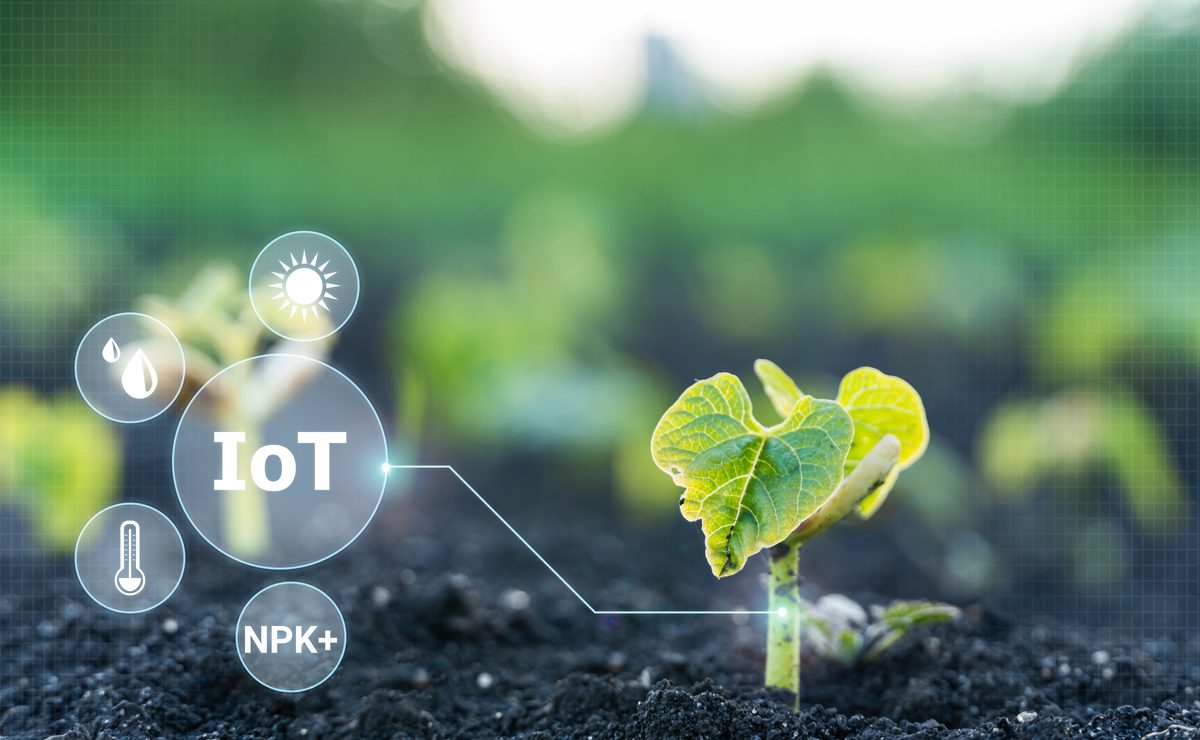Smart farming is an approach that uses technology and innovative techniques to enhance farming practices and improve agricultural as they allow farmers to collect and analyze real-time data to optimize crop yields, reduce waste, and increase efficiency. This blog will highlight the benefits of implementing IoT technology in smart farming. The technology will also be explored in some of its most promising applications.
Overview of IoT Solutions in Smart Farming
IoT solutions use sensors, devices, and platforms to monitor and manage agricultural processes and operations. These solutions can help farmers optimize resource usage, improve crop yields, and reduce waste. IoT devices and sensors can track weather conditions, soil moisture, plant growth, and livestock health, among other variables. Farmers can make informed decisions about crop management and livestock care by analyzing the data provided by IoT platforms.
Advantages of IoT in Smart Farming
One of the primary advantages of IoT in smart farming is improved crop management. Farmers can adjust irrigation and fertilization practices based on soil moisture and nutrient levels to optimize crop growth and reduce waste. IoT sensors can also track temperature, humidity, and other environmental factors, allowing farmers to adjust growing conditions for different crops and seasons. This data can be analyzed to develop predictive models, enabling farmers to plan and adjust crop cycles and harvest times.
Another advantage of IoT in smart farming is enhanced resource efficiency. Farmers can reduce waste and lower operational costs by monitoring water and energy usage. IoT solutions can also optimize livestock feed and nutrition, leading to healthier animals and increased productivity.
IoT solutions can also help reduce the environmental impact of farming practices. By optimizing crop management and reducing waste, farmers can minimize harmful pesticides and fertilizers, reduce water usage, and lower greenhouse gas emissions.
IoT in smart farming can also lead to better decision-making through data analytics. By collecting and analyzing data from sensors and devices, farmers can gain insights into crop and livestock performance, weather patterns, and other factors that affect farming outcomes. This data can be used to develop predictive models, enabling farmers to make informed crop and livestock management decisions.
Finally, IoT solutions can increase profitability for farmers by optimizing crop yields and reducing waste. By reducing operational costs and increasing efficiency, farmers can increase their profits and invest in new technologies and farming practices.
Use Cases of IoT in Smart Farming
Precision farming is one of the most promising use cases of IoT in smart farming. Precision farming involves using sensors and devices to monitor crop growth, soil moisture, and other variables. This data can be used to optimize crop yields and reduce waste, leading to higher profitability for farmers.
Livestock monitoring is another important use case of IoT in smart farming. It is possible to use IoT sensors to monitor the health and well-being of livestock, including tracking feed consumption and weight gain. This data can be used to optimize livestock nutrition and health, leading to increased productivity and profitability.
Soil monitoring is also a critical use case of IoT in smart farming. Farmers can monitor soil moisture and nutrient levels to optimize crop growth and reduce waste. This data can be analyzed to develop predictive models, enabling farmers to plan and adjust crop cycles and harvest times.
Irrigation management is another key use case of IoT in smart farming. IoT sensors can track water usage and soil moisture levels, enabling farmers to adjust irrigation practices to optimize crop growth and reduce waste. This can lead to higher crop yields and increased profitability.
Finally, supply chain management is an emerging IoT use case in smart farming. IoT solutions can track the movement of crops and livestock through the supply chain, ensuring they are handled and transported safely and efficiently. This can help reduce waste, improve quality control, and ensure that products reach consumers promptly.
Conclusion
In conclusion, IoT solutions in smart farming can revolutionize agriculture by improving crop management, enhancing resource efficiency, reducing environmental impact, enabling better decision-making, and increasing profitability for farmers. Precision farming, livestock monitoring, soil monitoring, irrigation management, and supply chain management are promising use cases of IoT in smart farming. IoT solutions in agriculture are set to become even more innovative as technology advances.
FAQs:
- How can IoT solutions improve sustainability in agriculture?
IoT solutions can monitor and reduce the use of resources like water, energy, and fertilizer, which can help reduce the environmental impact of agriculture. IoT solutions can also help farmers implement more precise and efficient farming practices, improving crop yields and reducing waste.
- How can IoT solutions help with pest and disease management in agriculture?
IoT solutions can monitor environmental conditions, such as temperature and humidity, to identify favorable conditions for pests or diseases. Farmers can then take action to prevent or treat the issue before it becomes a larger problem.
- Are there any potential drawbacks to using IoT solutions in agriculture?
One potential drawback is the cost of implementing IoT solutions and the ongoing costs of maintaining and updating the technology. Additionally, some farmers may lack the technical knowledge to effectively use IoT solutions.
- How can farmers ensure the security of their IoT systems?
Farmers can ensure the security of their IoT systems by using strong passwords, regularly updating software, and monitoring their networks for suspicious activity. Choosing IoT devices and platforms with strong security features is also important.
- How can IoT solutions help with supply chain management in agriculture?
IoT solutions can track the movement and storage of products, such as crops and livestock, throughout the supply chain. This can help ensure that products are handled properly and reach consumers promptly and safely. IoT solutions can also provide transparency in the supply chain, which can help build consumer trust and confidence in the products they buy.

